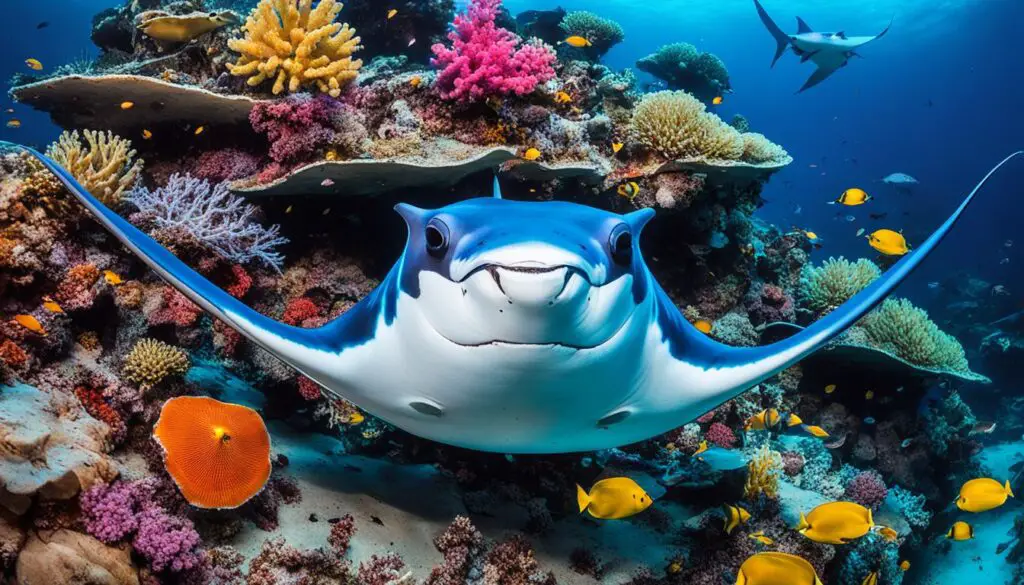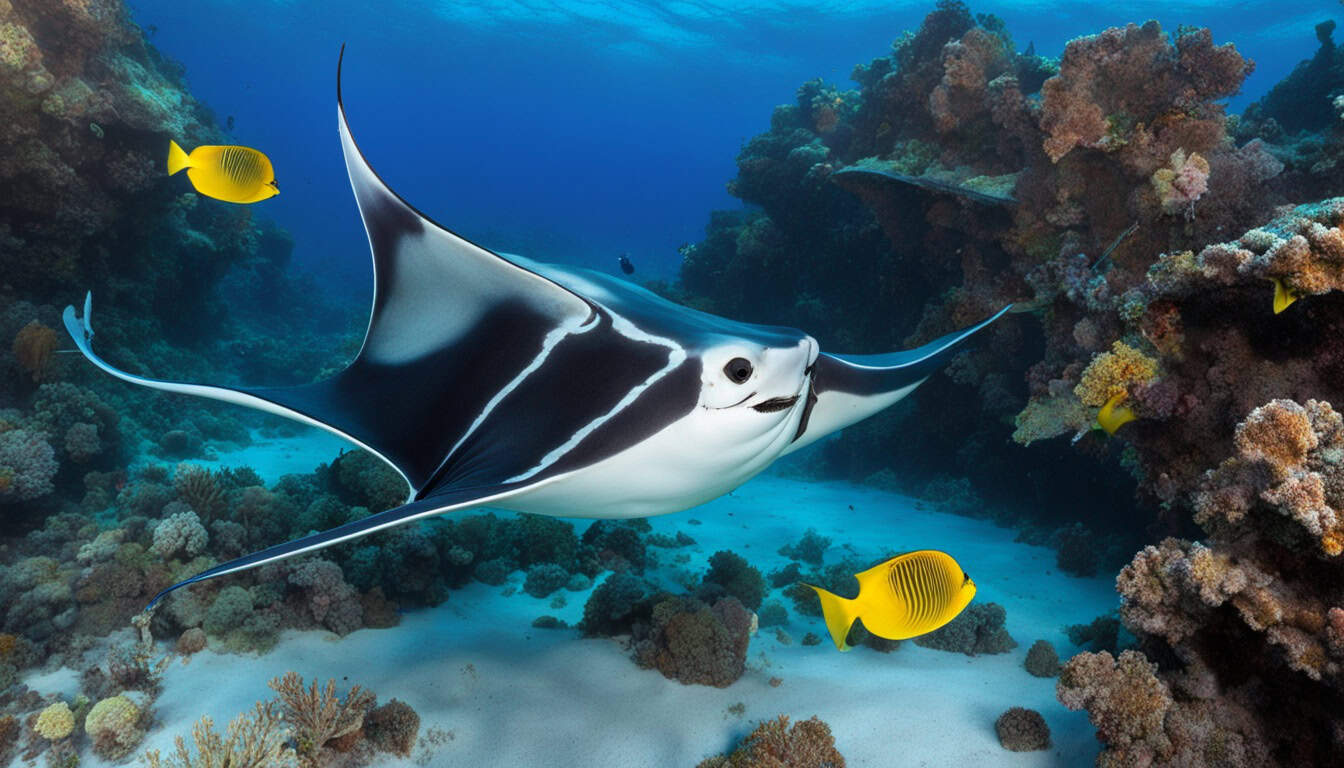Manta rays are fascinating creatures of the ocean. Understanding their manta ray lifespan helps us appreciate their role in marine ecosystems. These majestic animals can live between 50 to 100 years.
However, many aspects of their manta ray longevity are still a mystery. Some individual manta rays have been seen living in their natural habitats for a long time. This makes them one of the longest-living fish species.
The variations in manta ray life expectancy come from environmental conditions and biological traits. It’s important to study and conserve these remarkable beings.
Understanding Manta Rays
Manta rays are fascinating creatures that grab our attention with their unique features and behaviors. Learning about their classification, characteristics, and types can deepen our appreciation for these amazing marine animals.
Classification and Characteristics
Manta rays are part of the kingdom Animalia and the phylum Chordata. They belong to the subclass Elasmobranchii, the order Myliobatiformes, and the family Myliobatidae. A key feature of manta rays is their large, triangular pectoral fins. These fins help them glide smoothly through the water. Often, these fins can be quite long, making them look majestic while swimming.
Types of Manta Rays
There are mainly two types of manta rays, each with its own behaviors and habitats:
- Reef Manta Ray (Mobula alfredi): This type lives in coastal waters and likes clean environments, often found near coral reefs.
- Giant Manta Ray (Mobula birostris): Known for its long migrations, this manta ray type can travel vast distances across the ocean, reaching wingspans up to 22 feet.
How long do manta rays live?
The lifespan of manta rays is quite interesting. They can live from 50 to 100 years in the wild. This long life is influenced by many factors that affect their growth and survival.
Manta Ray Lifespan Overview
The length of a manta ray’s life changes a lot based on where it lives and its own traits. Scientists study these creatures to understand their lifespan better. Rays do best in places with stable environments.
Factors Influencing Lifespan
Many things affect how long manta rays live, including:
- Ecological Conditions: The health of their living space and food availability are key.
- Predation Risks: Fewer predators mean they can live longer.
- Human Impact: Fishing, tourism, and pollution can harm their life span.
- Reproductive Habits: They start reproducing at 10 to 15 years old. Their slow breeding adds to their lifespan.
Manta Ray Longevity in the Wild
The life span of manta rays is truly fascinating. In the wild, they live about 50 years on average. Some have even lived up to 100 years, showing they can live a long life.
Estimates of Natural Life Expectancy
Studying manta rays helps us understand how long they live. Things like their environment and who eats them affect their life span. Knowing this helps us learn more about the ocean and why manta rays are important.
It’s crucial to protect their homes to help them live longer. This is key for keeping these amazing creatures around.
Notable Long-Lived Individuals
One manta ray was watched for over 45 years in Hawaiian waters. This shows how long some can live. Watching these rays helps scientists learn more about their lives and behaviors.

The Manta Ray Aging Process
Manta rays have a unique way of aging that is key to understanding their life cycle and how to protect them. Knowing how fast they grow and when they reproduce helps scientists make better conservation plans.
Growth Rates and Maturity
Manta rays grow slowly, which affects their lifespan. They become ready to reproduce between 10 to 15 years old. The size and growth rate vary among species. Reef manta rays are smaller and grow more slowly than oceanic ones.
Things like the environment, food, and how many are around can change how fast they grow.
Reproductive Age and Lifespan
At about 10 to 15 years old, manta rays start reproducing. They carry their young for about a year before giving birth to one pup. After that, the baby manta rays are on their own, with no help from their parents.
This fact is important for understanding how well they can survive in the wild.
| Species | Average Lifespan (Years) | Growth Rate (cm/year) | Reproductive Age (Years) |
|---|---|---|---|
| Reef Manta Ray | 10-15 | 15-25 | 10-15 |
| Giant Manta Ray | 20-30 | 20-30 | 10-15 |
Research on Manta Ray Lifespan
Scientists are always studying how long manta rays live. They use many methods to learn about their age and growth. This helps them understand how to protect these amazing creatures.
Studies and Observations
Field research has greatly improved our knowledge of manta rays. Scientists watch them to learn about their lives and where they live. They use tags to track mantas, helping them understand how the environment affects their lives.
Tracking Manta Rays for Lifespan Data
Tracking manta rays is key to understanding their lifespan. It helps scientists see where they go and how they live together. Conservation groups keep records of where they see mantas. This info helps scientists know how to protect them from harm.
FAQ
How long do manta rays typically live?
Manta rays usually live between 50 to 100 years. But, some may live longer or shorter lives.
What factors influence the lifespan of manta rays?
Many things affect how long manta rays live. This includes their environment, the risk of being eaten, and how often they have babies.
Are there known long-lived manta rays?
Yes, there is a manta ray named Lefty who has been alive for over 45 years. This helps us learn more about how long they can live.
At what age do manta rays reach sexual maturity?
Manta rays become ready to have babies between 10 to 15 years old.
How do researchers study manta ray lifespans?
Scientists use tags and monitoring to track manta rays. This helps them learn more about how long they live and grow.
What is the gestation period for manta rays?
Manta rays are pregnant for about 12 to 13 months. After that, they have one baby.
Do manta rays provide parental care to their pups?
No, manta rays don’t take care of their babies. The babies have to find food and take care of themselves right after they’re born.
How does human impact affect manta ray longevity?
Humans can harm manta rays by destroying their homes and polluting the ocean. This can shorten their lives and make them sick.







